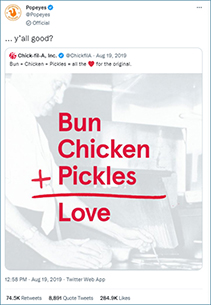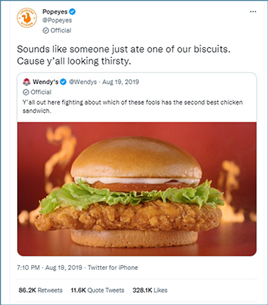
It's no secret that people love a good feud. Before social media, rappers would battle through their albums, and celebrities would take jabs at each other in magazine interviews or newspaper articles. Audiences are captivated by a good-natured argument. Sports rivalries, such as the Arkansas and Texas A&M football games, are a perfect example of how these intense matchups draw passion and excitement among fans. Brands are no different from public figures and celebrities in this regard. With the rise of social media, feuds have become a popular marketing strategy for fast food companies seeking to establish their voice on social media. These interactions allow brands to adopt human-like personas and online language to bring in an audience.
 If you remember the Popeyes chicken sandwich craze of 2019, you can recall an example of this type of feud. Amidst the ruckus of sold-out
locations, celebrity engagement, and many, many physical and verbal brawls over the
famous menu item, many other fast-food locations looked to join the fight. Most notably,
Chick-fil-a inserted themselves into the craze with a tweet which read “Bun + Chicken + Pickles = all the [heart] for the original.” Popeyes followed up only a few hours later with a quote tweet saying, “… y’all good?” Shortly after this interaction, Wendy’s also posted a tweet that read, “Y’all out here fighting about which of these fools has the second best chicken sandwich.” Popeyes replied, “Sounds like someone just ate one of our biscuits. Cause y’all looking thirsty.”
If you remember the Popeyes chicken sandwich craze of 2019, you can recall an example of this type of feud. Amidst the ruckus of sold-out
locations, celebrity engagement, and many, many physical and verbal brawls over the
famous menu item, many other fast-food locations looked to join the fight. Most notably,
Chick-fil-a inserted themselves into the craze with a tweet which read “Bun + Chicken + Pickles = all the [heart] for the original.” Popeyes followed up only a few hours later with a quote tweet saying, “… y’all good?” Shortly after this interaction, Wendy’s also posted a tweet that read, “Y’all out here fighting about which of these fools has the second best chicken sandwich.” Popeyes replied, “Sounds like someone just ate one of our biscuits. Cause y’all looking thirsty.”
Quickly, the feud between these brands went viral, accumulating thousands and thousands of likes, retweets, mentions, etc. Interactions such as this show the potential for online feuds to swiftly reach large audiences, expanding outreach and engaging broader social media communities. Specifically during new product launches, banter such as this can target potential customers of the involved brands. New research by Ashutosh Bhave looks at the effects these interactions can have on a brand.
Bhave, assistant professor of marketing at the Walton College of Business, seeks to understand the impact of these interactions in his recent article, “Clashing on Social Media: Exploring the Impact of Twitter Banter Among Competing Fast-Food Brands.” Along with co-authors Sriharsha Kamatham (University of Manitoba) and Norris Bruce (University of North Carolina at Chapel Hill), Bhave reveals substantial implications for social media managers looking to engage in impromptu banner with rival brands.
Benefits and Backlash of Brand-to-Brand Dialogue
Prior to social media, brands could engage with one another through various formats. Billboards and commercials allowed comparative advertising and were often used through employing humor and satire to compare themselves to other brands. In 2009, BMW and Audi engaged in what is now referred to as the “billboard wars.” Both companies engaged in a back-and-forth banter regarding who was the “chess master” of the car world. Today, companies don’t have to wait for billboards to go up or commercials to air, but instead are able to create immediate and direct responses to mentions. The rise of social media has allowed for a new era of brand-to-brand dialogue.
Interactions such as these long been prevalent on social media. Brand-to-brand dialogue differs from other types of advertisements or posts such as marketing literature or comparative advertising. Marketing literature focuses on social media interactions between brands and their consumers. This is often seen by companies such as Duolingo and Starry who maintain constant communication with their consumers on TikTok. Comparative advertising occurs when brands implicitly or explicitly compare themselves with rivals without eliciting a spontaneous response. Dove often employs this technique when they compare their soap to other brands. Bhave’s research, however, focuses specifically on brand-to-brand dialogue which is characterized by sarcastic and sometimes abrasive exchanges between brands. These interactions often resemble the playful banter of friends or “frenemies.”
There is much discussion surrounding how marketing techniques affect businesses. Previous research says that comparative advertising can be effective in grabbing viewers' attentions and bringing awareness to a brand. However, negative comparisons such as ones often seen in political campaigns can lead to backlash. While this is known, the hole in research that Bhave seeks to fill is how brand-to-brand communication on social media affects the brands involved.
The first and perhaps most clear result is that banter heightens customer engagement. As mentioned before, social media users thrive on conflict, meaning that any type of back and forth between brands is more likely to go viral. However, when brands use disparaging humor in this banter, it can sometimes lead to negative attitudes toward the initiating brand. For example, in the Popeyes feud, Chick-fil-a and Wendy’s tweets caused some backlash for both of their companies. In response to their posts, both companies received many replies. One user replied to Chick-fil-a with a pointed comment about pickles and buns, indirectly referencing the company’s controversial support for anti-LGBTQ+ organizations. This tweet was accompanied by many more that followed the same pattern of anti-Chick-fil-a posts. Wendy’s also received many negative comments saying things such as, “*best chicken sandwich that takes 50 minutes to make and comes out cold.*” These tweets are prime examples of negative attitudes that can arise after initiating disparaging brand-to-brand banter.
While Chick-fil-a and Wendy’s tried to recover from the backlash created by their tweet, Popeyes thrived. In fact, Bhave found that Popeyes observed a 426% increase in Google searches while searches for the two other companies did not increase at all. There was also a similar increase in Popeyes’ in-store visits while Wendy’s and Chick-fil-a visits stayed the same. This information shows that while brand banter can be extremely beneficial for a company, it is much more beneficial to be the on the receiving end and creating a witty response, than it is to create the initial jab.
Keep These Things in Mind
Bhave highlights the significance of speaking your audience's language when participating in brand-to-brand conversations on social media, emphasizing its pivotal role in increasing engagement. While many companies tend to keep their advertising professional, even on social media, there can be benefits to using common language seen on social media. Using various terms and slang in social media posts can help create an online persona that will connect with the audience on a personal level. The use of words such as “y’all,” “sounds like,” and “thirsty” in Popeyes tweets connected with their audience and gave them a more personal feel which appeals to many social media users.
This information is particularly useful during the launch of a new product. New menu items themselves are a key part of marketing activities as they affect pricing, branding, and advertising. The Grimace Shake from McDonald’s is a great example of a new product being vital in marketing for a company. Weirdly enough, the Grimace Shake became a viral sensation on TikTok, with users creating videos staging their brutal deaths after drinking the shake. The virality of the shake helped increase McDonald’s sales over 11% in the second quarter of 2023.
 Using this example illustrates the critical importance of a strong social media presence
during the launch of a new product for any company. Because of this, social media
managers should be particularly careful when instigating social media banter if the
opposing company is launching a new product. Because banter is more beneficial to the replying party, it is likely going to give
competitors an upper hand as they release their new product. If one does engage despite this risk, they should first try to think of a way to
infuse humor as opposed to using disparaging tones. If not, negative comparisons on
social media can quickly result in the opposite of the intended effect, bringing negative
attention onto the initiating company.
Using this example illustrates the critical importance of a strong social media presence
during the launch of a new product for any company. Because of this, social media
managers should be particularly careful when instigating social media banter if the
opposing company is launching a new product. Because banter is more beneficial to the replying party, it is likely going to give
competitors an upper hand as they release their new product. If one does engage despite this risk, they should first try to think of a way to
infuse humor as opposed to using disparaging tones. If not, negative comparisons on
social media can quickly result in the opposite of the intended effect, bringing negative
attention onto the initiating company.
What Does this Teach Us?
The Popeyes chicken sandwich craze is a perfect example of how clever brand-to-brand dialogue can grab public attention and increase customer engagement. Examples such as these make it evident that these interactions play a significant role in modern brand communication. However, as Bhave’s research highlights, companies must tread carefully. Initiating brand feuds on social media can often backfire, as seen by Chick-fil-a and Wendy’s.
Bhave’s research further suggests that social media managers must be thoughtful about the timing and tones of their social media posts, specifically during new product launches. Rather than initiating conflict, brands might benefit more by crafting witty and quick responses that click with their audience. By being relatable and creating a persona that matches their audience, companies can expand their reach. If brands can prioritize authenticity and humor while engaging in social media feuds, they might be able to maximize the positive impact on their marketing efforts that social media has the potential to produce.
 Kaslyn Tidmore is a second-year graduate student at the University of Arkansas, earning
her master’s degree in public relations and advertising. Before relocating to Arkansas,
Kaslyn graduated from the University of Oklahoma with a bachelor’s degree in print
journalism and a minor in editing and publishing. During this time, she interned with
publications such as, Parker County Today Magazine, WedLinkMedia, Modern Luxury, and
the school’s newspaper, the OU Daily. Following her role as the graduate assistant
to Editor-in-Chief Ryan Sheets, Kaslyn now serves as a GA in the Center for Media
Ethics and Literacy at the School of Journalism and Strategic Media.
Kaslyn Tidmore is a second-year graduate student at the University of Arkansas, earning
her master’s degree in public relations and advertising. Before relocating to Arkansas,
Kaslyn graduated from the University of Oklahoma with a bachelor’s degree in print
journalism and a minor in editing and publishing. During this time, she interned with
publications such as, Parker County Today Magazine, WedLinkMedia, Modern Luxury, and
the school’s newspaper, the OU Daily. Following her role as the graduate assistant
to Editor-in-Chief Ryan Sheets, Kaslyn now serves as a GA in the Center for Media
Ethics and Literacy at the School of Journalism and Strategic Media.




